Wednesday, August 27
Steve: We decided to spend today in Asia. With Talya as our guide for the day, we took a simple 20 minute ferry ride across the Bosphorus, and we were there! Talya told us that there's a "Welcome to Asia" sign on the bridge for those who travel by car, but it certainly wasn't worth the 1-2 hour travel time by car (more on this later), so we had to be satisfied creating our own little welcome…
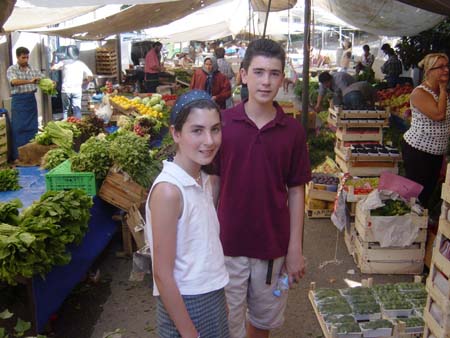 We
decided to walk through some of the Asian neighborhoods in order to get a
feel for life in this part of the city. It was interesting to see the wide
mix of homes - we saw luxury villas right on the water, just across the street
from very modest and sometimes run-own homes where most of the people live.
We also spent time in another outside market that specialized in fresh produce.
We
decided to walk through some of the Asian neighborhoods in order to get a
feel for life in this part of the city. It was interesting to see the wide
mix of homes - we saw luxury villas right on the water, just across the street
from very modest and sometimes run-own homes where most of the people live.
We also spent time in another outside market that specialized in fresh produce.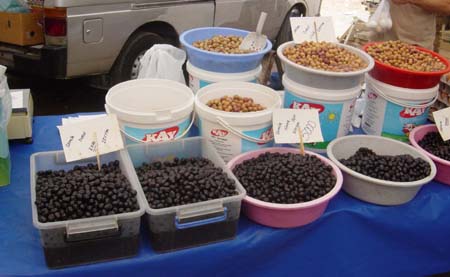 Markets like these are where most people like to buy their fruits and vegetables.
Our favorite food being sold here were the olives - the aroma was great!
Markets like these are where most people like to buy their fruits and vegetables.
Our favorite food being sold here were the olives - the aroma was great!
We walked along the shore, and made the Sultan's Summer Palace our first
stop. The palace is called Beylerbeyi Sarayi, and was built in the late 1800's
by the Sultan Abdulaziz as a "little getaway." The palace has 30
rooms, and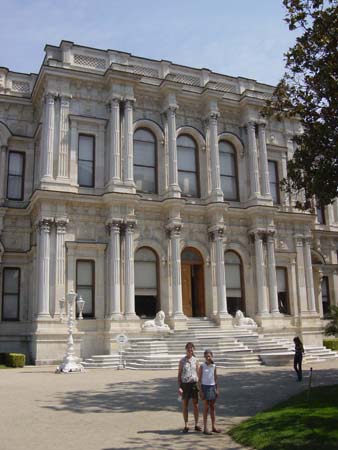 extremely impressive, especially with its location right along the Bosphorus.
The palace was divided into a section for the Sultan's private chambers (including
two separate bedrooms used by his 2 favorite wives at the time), and a section
for official meetings and events. We probably enjoyed visiting this palace
more than any other so far, largely because we were just about the only visitors
inside (we understand that most tourists stay on the European side of the
city). It was great to be able to walk through the rooms and admire the original
furniture, chandeliers, carpets and artwork without the crowds that normally
accompany our visits to palaces.
extremely impressive, especially with its location right along the Bosphorus.
The palace was divided into a section for the Sultan's private chambers (including
two separate bedrooms used by his 2 favorite wives at the time), and a section
for official meetings and events. We probably enjoyed visiting this palace
more than any other so far, largely because we were just about the only visitors
inside (we understand that most tourists stay on the European side of the
city). It was great to be able to walk through the rooms and admire the original
furniture, chandeliers, carpets and artwork without the crowds that normally
accompany our visits to palaces. 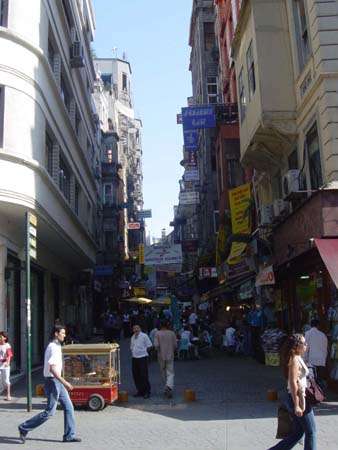
For lunch, we took a taxi to a town called Kanlica, further north along the Asian shore. We enjoyed a leisurely lunch with Talya at a waterfront restaurant, and spent time walking around the small village. We also stopped into a small grocery store to continue our project where we track the price of specific foods in each country that we visit. We're recording these prices on a chart and plan to post this to our web site soon.
Paula: Our last stop of the afternoon was Istiklal Caddesi (Independence
Avenue). Our taxi let us out in the middle of a busy (but typical) street
in this modern section of Istanbul. There were cars, many taxis and even trolleys
running along the square. The rowded trolleys looked like those found in San
Francisco and the kids got a kick out of the young boys who hopped on the
back for free rides. Is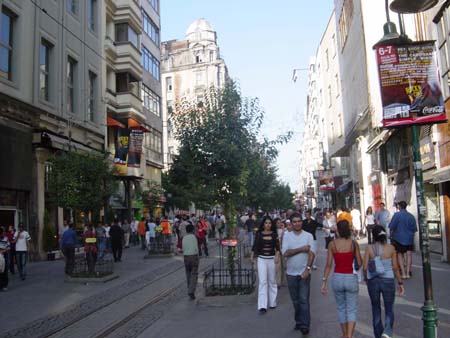 tiklal
was the location of the most elegant shops and restaurants during the Ottoman
Empire. Today, the street is a center of activity, and stays extremely busy
until late at night. There are people of all ages crowding the walkways, with
a wide variety shops and cafes lining both sides of the street. Narrow side
streets shoot off Istiklal and these are filled with open air stands selling
food and other products. After spending time window-shopping and watching
the people, we took a taxi back to our hotel to rest and recover from the
heat.
tiklal
was the location of the most elegant shops and restaurants during the Ottoman
Empire. Today, the street is a center of activity, and stays extremely busy
until late at night. There are people of all ages crowding the walkways, with
a wide variety shops and cafes lining both sides of the street. Narrow side
streets shoot off Istiklal and these are filled with open air stands selling
food and other products. After spending time window-shopping and watching
the people, we took a taxi back to our hotel to rest and recover from the
heat.
Istanbul is not an easy city to get around, which is why we've had to take so many taxis. There is a subway system, but much of the city isn't covered, and we haven't been able to take advantage of it at all. The traffic is very bad, and having to take taxis in the heat of the afternoon has been difficult. We understand that the subway system is being expanded to extend into other areas (including the historical parts of the city), but this project has been going on for years.
The heat has been difficult to adjust to and we have heard from the locals
that it is even worse this week than usual. One forecast said that Istanbul
is experiencing hot winds blowing from France, and that these temperatures
will last here for another two weeks. Just our luck… Of course, we know
that probably means that we're in for even worse heat in Greece. We've adjusted
fairly well to the temperatures, but the heat certainly takes its toll on
us over the course of our days. 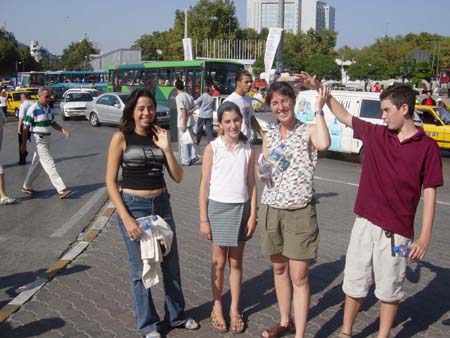
David and Katie insisted on taking Talya to our favorite spot for dinner. It seems funny that after being in Istanbul a total of four days, we already act like we know the best place for dinner-but anyway, it was back to Buhara 93 for kebobs! Talya had promised us a lesson in speaking Turkish and we had fun practicing a few basic words. We also spent time at dinner sharing stories about sports, especially soccer and American football. One of the teams from Turkey was playing an important soccer match this evening and we were amused to find that Talya's cell phone beeped every time a goal was scored in the game (this sounds more like something we'd do at home!).
We have all enjoyed getting to know Talya better and her descriptions about the life and history of Turkey are always more interesting than the information in our books. We've learned much about life here, and have had several conversations with Talya about Turkish history, housing, families, education, health care, sports, food and the economy. Turkey is certainly a very interesting country with a rich history.
Distance Walked: 2.54 miles
David's Download - Today, David's Download will feature a discussion
of Turkish currency and Turkish cuisine…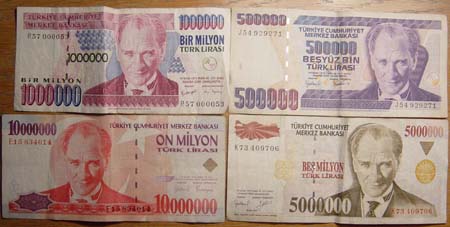
The official currency of Turkey is the Turkish Lira. The Lira has been one of my favorite currencies because of how different it is from any other currency in Europe. The conversion rate is 1,384,705.47 Lira = $ 1.00!!! It is also quite amusing to look at this rate backwards. One Lira = $ 0.000000722175!! We have seen bills that range from 250,000 lira to 20,000,000 lira, although there might be bills of greater value. There are also three coins ranging in value from 50,000 lira to 250,000 lira. I especially like collecting the coins from each country we visit. I like big, heavy and unique coins. The 50,000 lira coin is my favorite because of its size and appearance. It is a golden and copper coin with a big number 50 and the Turkish symbol (a crescent moon next to a star) on the front. On the back there is an engraving of Ataturk, a man who formed the Republic. We found this currency extremely perplexing and confusing. We were all in a state of shock when we saw that our plane tickets to Athens would cost two billion lira. We had never paid two billion for something in our whole lives! We were told that many shopkeepers will rip you off by giving you 500,000 lira as change instead of a 5,000,000 lira. It's very hard to recognize the value of a bill without counting the zeros or memorizing the colors of each bill. Turkey is working on meeting the requirements to join the European Union. If they are admitted, the Euro will slowly become the new currency of Turkey. Many countries that have taken on the Euro have claimed that the prices have increased by 30% and many citizens regret voting to be a part of the EU.
Turkish cuisine has been by far the best we have had on the trip so far (I'm counting on the Italian food being twice as good!). Breakfast is eaten at seven o'clock and usually consists of bread, butter, white cheese, honey, juice or tea, small amounts of meat, vegetables such as cucumbers and tomatoes, and my favorite fresh black and green olives. Lunch is usually eaten around midday, and is very light. Most people buy snacks on the streets instead of a sit-down meal. You can find nuts, baked potatoes, pretzels, thick and creamy ice cream, and corn on the cob all over the streets. The main and most important meal of the day is dinner, which is eaten at 7:00. Meat is a very important part of dinner in Turkey. Lamb, beef, chicken and turkey are common grilled meats. According to their faith, Muslims are not allowed to eat pork, so it is seldom seen in the city. Meat is usually served in the form of a kabob, marinated from one to two hours! The marinades give the meat such a powerful flavor and juiciness, that it seems as if it melts in your mouth. My favorite Turkish dish is a mixture of kabobs, such as beef, lamb, and chicken, Turkish pizza, rice pilaf, grilled tomatoes, hot peppers, bread with melted cheese, and meatballs. This is served on a huge dish, which everyone shares. My family and I have enjoyed this meal so much, that we have already been to the same restaurant three times in two days! Soup and fish are also commonly found in Turkey and are important parts of people's diets. Tea in Turkey is very favorable, served in small glasses. You can get very strong apple, orange, or plain tea. Tea is so important, that we often see men wearing traditional clothing with a large golden pot on their back filled with tea. They serve the tea on small silver platters. Another common drink is "Ayran." I found it disgusting, salty, and sour. It is made with yogurt and water. The desserts are very sweet, usually made with honey. A common dessert is baklava, a syrup dipped pastry. Trying different food from around the world has been an adventure in and of itsself!
